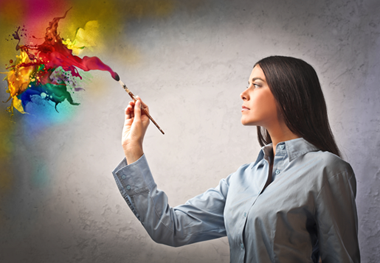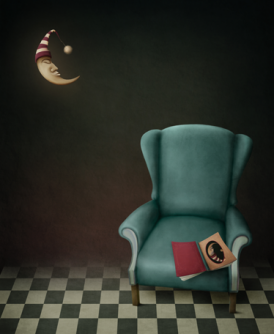Play with Paints
Choose a private place to set up your painting supplies and a time when you will not be interrupted. Before you begin, take a few moments to relax. The visualization below may help you. You can do this visualization as you’re reading it, or you can read through the directions once or read them into a tape recorder and then do the visualization.
Visualize
Sit in a comfortable position and take a few deep breaths, feeling the air fill your diaphragm and lungs, and feeling the tension flow out of your body as you release your breath…. You can close your eyes if you want to and begin to let go of any concerns or worries…. With every breath you feel yourself sinking deeper into relaxation…. Your back eases into the chair…. Your heels sink into the floor…. You feel deeply connected to the ground beneath you…. Now check in with all the parts of your body and release any tension you may find there…. Imagine a sensation of gentle warmth flowing through you, loosening any tightness you might feel…. Imagine a golden light surrounding you … keeping you safe and warm…. Allow the golden light to go any place in your body where you want to relax even more deeply…. You feel completely at ease now … open to receiving the images that come into your awareness.
Go back in your mind to a time when you were young and very happily playing….You played pretend with your friends … or all by yourself…. It was fine to be alone with your imagination…. It was so easy to play with the ideas and images that came into your mind…. Remember the pictures you drew with your crayons and how you enjoyed the shapes you created. Remember the paints you played with … and how absorbing and beautiful the colors were … how easily and freely the brush flowed across the page…. Today as you play with paints you can easily recapture the feeling of openness, connection, and peace that you felt as a child when you were absorbed in the act of creation…. It is easy for you to draw freely from your imagination.
When you are ready, gently bring yourself back into present awareness, bringing with you a renewed and refreshed feeling, being in touch with the playful part of yourself, feeling ready to play with paint.
Paint Playfully
Put a little paint in your paint tray, dip your brush in a bowl of water and then in the paint, or mix your paint with a little water on the tray, and run your brush across the page. Don’t worry about where you’re going with this. Just take a few minutes to experiment with the paints and get the feel of how much water you need to make the color flow. With more water you’ll get pastel colors. With less water you’ll get darker and brighter colors.
When you feel comfortable with the paints, start with a fresh piece of paper and let yourself play. Instead of deciding what you want to paint, let yourself be drawn to the colors intuitively and see what shapes evolve as you move your brush across the page.
You might paint an abstract image, a circular image or mandala, or something whimsical or realistic. Whatever comes to you is fine. Let your mind go, the same way you do when you’re doodling or driving on an empty highway or swaying to music you love. Let the image evolve in whatever way it wants to.
Reflect and Write
As you finish your painting, allow some words to come into your mind. Take a few moments to reflect on your image and see what it suggests to you. You might want to start by saying, “In this picture I see …” or “In this picture I feel …” or “When I step into this picture I am in a place of … where I discover …” When you feel ready, spend a little time writing. Let your intuition guide you.
Later you may want to write about how this experience affected you. What was it like to paint without a goal or purpose? What did you learn about the medium and your approach to it? How did it feel to write after meditatively painting?
How This Exercise Worked for Me
This painting and writing exercise came straight out of one of my dreams: I was painting pictures, writing captions for them, and then making books out of them. Some of the pictures were quite good, which surprised me since I’m not a graphic artist. Some were not so good, and it didn’t matter, because I was having fun. My mentor encouraged me to make the dream concrete by painting in a meditative way and writing captions on my paintings, and later by telling stories from the pictures I painted.
Here are some notes from my journal about what happened: “I painted a picture of the moon. As I was painting, I thought I knew what I wanted the caption to say. I thought I knew how I wanted the picture to look. I thought it was more about the night sky than about the moon. I thought the moon would be just a sliver.
“But as I was painting, the moon became full. The star I thought would be next to it never appeared. Clouds showed up instead. I forgot what I wanted the caption to say. As I finished the picture, I saw that it didn’t look anything like what I’d imagined. And a new caption—a different caption—a more beautiful caption—came into my mind. It was a caption for the picture I painted, not for the picture I had imagined I would paint.”
From this experience, I learned patience; I had to let one color dry before I painted over it, unless I wanted to mix colors on the page. I learned that I don’t have control over the way the paints interact with the paper—and that’s okay. I learned that even though I don’t regard myself as a painter, I can still create images that have power and deep personal meaning. I learned, too, that the process of writing can be as fluid as the process of painting, if I bring to my writing the same childlike openness and willingness to explore as I bring to painting.
Paint flows onto a page much differently than words do, and the differences can be instructive. If you like this exercise, consider doing it once a week. Post your paintings on your wall or gather them into your journal.



0 Comments